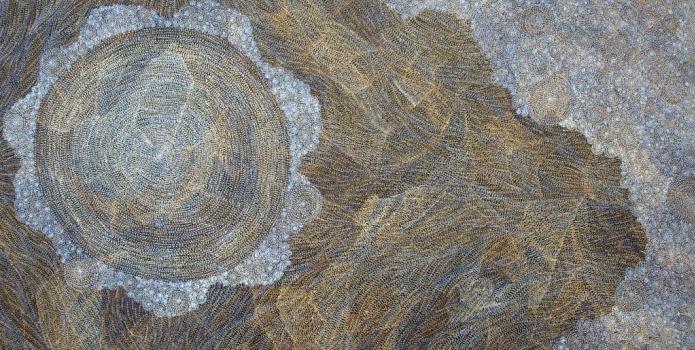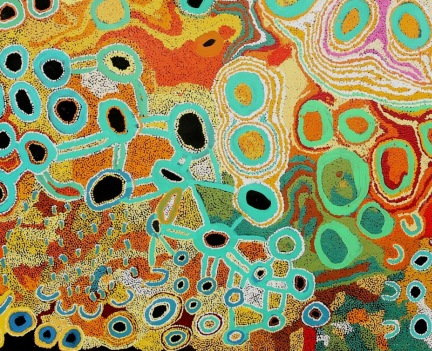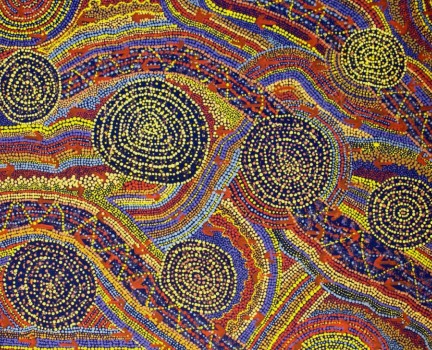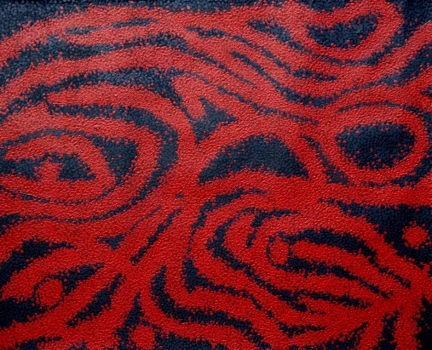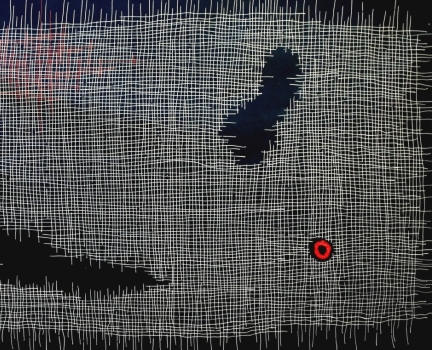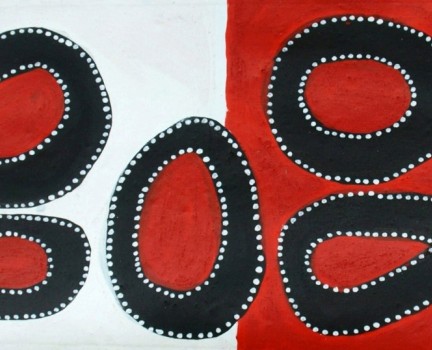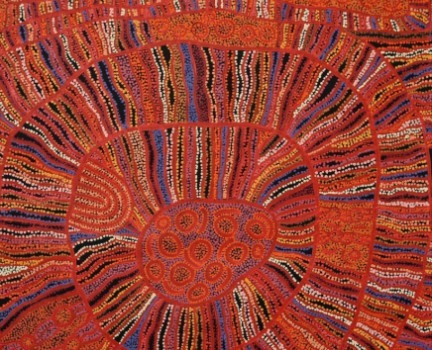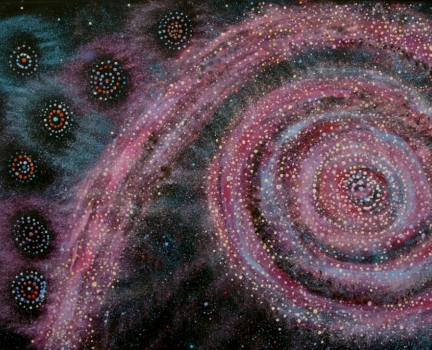Indigenous and Endogenous – Cell Biologists and Aboriginal Art?
In 2015 Professor Nadia Rosenthal was Founding Director of the newly formed Australian Regenerative Medicine Institute at Monash University. She talks here about what she and other cell biologists see when they look at aboriginal art. She reflects on the connection between the images of cells as seen through a powerful microscope, and the motifs in aboriginal painting.
Q: Your art collection fills the walls at the Institute. What do the scientists you work with say about the aboriginal art in their workplace.
A lot of the Aboriginal shapes and motifs lend themselves to biological interpretation. There's something uncanny about the Aboriginal concept, and the way that they extract meaning out of their landscape and out of their culture. It is invariably biological, it has real meaning for biologists.
We will look at an Aboriginal painting, for instance, this one here, the Women's Collaborative Kungkarangkalpa (see image top right). That's a very complex painting with many circles and a number of the motifs. There are motifs of song lines and other sorts of recognizable motifs even to an amateur like myself. These are reminiscent of what we see under the microscope, and yet they have Aboriginal meaning, arcane and esoteric.
As scientists, we've always felt that the indigenous represented a true reflection of endogenous biological reality. For a while, I was thinking I would actually try to run a show - which I've told David about - called, "Indigenous endogenous". It would have some of the more beautiful images that we generate on microscopes, exhibited with some of the art that reflects those realities.
Another idea I had about 20 years ago was to bring microscopes into the artist communities and let them look down the microscopes to see what it is that we're looking at and ask them to respond. Because I think they would just go, "Oh, yeah, we know what this is."
Because they would see, exactly, these motifs showing up. There's something about the way in which the mind interprets culture and history and geography. I mean, this is going out on a limb, but it probably has roots in the way our minds are actually wired. The fanciful way of bringing this all together is that, when humans are making art, they are themselves biology and the way their minds are wired is biological. It's not totally surprising that the way they see the world, especially if they are as refined as these Aboriginal artists are in terms of their impressions. It is not so surprising to me that some of the basic biological shapes would not come forth. On the other hand to tell you the truth when I fly across Australia and I look down. It's like one Aboriginal painting after another. All I can think of is, how was it that these people were able to project onto a two-dimensional surface, something that they saw literally flat from the ground level but were able to get this extraordinary perspective on something that we would have to go up in an airplane to see.
I spent about two months studying some of the work on Clifford Possum just to try to understand the imagery and the iconography. The more I read about it, the more I realized that we would need to take our own western trained minds and stretch them both spatially and temporarily to get any kind of a sense of how they're actually envisioning the world. I think it's good for scientist to look at this because it makes them think about what they're actually doing with their own research and how they're interpreting their own images.
Jack Dale And The Immune System
The last painting I bought was a very long thin Jack Dale painting. The background is half white on one side, half red on the other. One of those beautiful reds that he used. Throughout the painting with the two different backgrounds, he's got enormous circles of different colors, white and red, with designs around them and sort of black rings. It's hard to describe, these paintings. It's a very simple painting in many ways. It doesn't have that much imagery, it doesn't have dots, it just has these circles.
At the time, I was looking at some of the parameters that control the regenerate process in vertebrates and in animals. What was becoming very very clear to me was that the immune system was absolutely critical in permitting regenerative processes which, otherwise, would be stymied. We are essentially, probably, the least regenerative animals on the planet. Most of the other animals in the evolutionary tree are much more regenerative than we are. One of the reasons for that is probably because we have very complex immune systems. This is what I'm working on right now. It's my research.
The cells are red and white cells. They are the cells of the blood. I had it hanging next to my office door. One day I looked at it and I felt, "My God, this painting, the reason I bought is because I'm working on this." Even though that's not the story the artist was telling. He didn't think of it as blood. A very very famous scientist in my field, an immunologist from Stanford University came to visit about two weeks ago and I asked him, "What do you think of that painting?" He said, "Oh, well, it's the immune system." I said, "Yeah." He said, "Is this an Aboriginal painting?" I said, "Yes." He said, "Did the artist know about the immune system?" I said, "Of course not. This is a painting of his country." It was just that moment when we both thought the same thing which is, it's not clear that you need to cut things up into little pieces, that the imagery can really drag you right across a number of experiences. That painting is one that I'm enjoying very much right now because I look at it ever time I walk into my office.
Regeneration - Seeing Patterns
Q: Is there a connection that you see between the paintings and the work in regeneration?
One of the predominant features of tissue regeneration or organ regeneration in animals and in plants for that matter, it's a recapitulation of the original form when it's messed up, either by damage or a disease or loss. That recapitulation has to go back to basic principles of how these organisms were developed in the first place. On top of that, those principles have to be, in some ways, recapitulated in an adult setting. Because if you're an embryo, you're growing from a tiny little thing and each bit of you is very well defined in a genetic sequence that works every time. You get a fly every time, you get a mouse every time. You don't get a mouse with five legs, you get a mouse with four every time. Most people don't even think that that's a miracle but it is when you know how complicated it is to make a mouse.
Putting this in the context of regeneration, I work on, for instance, salamanders that can regenerate whole limb. If they end up with one limb lost, they can regrow it. This is the same for a tail or just about any part of their body. What they have to do is, essentially, regrow the entire pattern that was there before. They have to recapitulate it out of thin air as it were. There's information in the cells that are there to divide and make new tissue. That is mysterious to us. We don't understand how that actually works. One of the things that happens in regeneration is that, you get pattern out of what looks like non-pattern.
In cancer, you get non-pattern coming out of patterns. A tumor is a non-patterned tissue that is out of sync and it's growing too much, too fast. Whereas, when you're regenerating, you have to start from a cut off limb or damaged tissue and reconfigure it, get rid of the scar and then regrow it so that it's as good as new. We don't think about this. We know we cut our skin and grow it back and within a month there's no scar or we just assume that's just the way things work. Try to do that to an automobile, the automobile doesn't grow scratches back. How do we do that? The answer is through a recapitulation of pattern that has been laid down in our genes since the get-go. I mean, this is obviously sort of a poetic extension but I think that the way in which the Aboriginals find and recreate and extract pattern out of what looks to us like just a wasteland or what the white man just saw as bush.
White people thought the outback landscape was empty but there's nothing empty about it obviously. That is the way in which I think about how these paintings. They extract the information out of what looks to the naked eye as nothing much. These artists create something that doesn't appear to have much pattern and turn it into incredible pattern.
Read more:
- Microscopes, Paint Brushes & the Bones of Life
- View paintings by Sarrita King
- View paintings by Jack Dale Mengenen
- Read Layers of Meaning in Aboriginal Art?
- Read about Aboriginal Art and A Workplace Culture of Creativity

